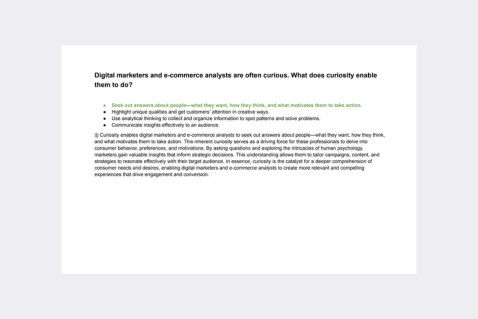An e-commerce business informs users that its checkout page has a secure connection for purchases. Which website optimization recommendation is this an example of?
Know what visitors want and give it to them
Make the website useful and interesting
Act in a way that gains user trust
Clearly indicate expertise and authoritativeness
Certification program: 👉 Google Digital Marketing & E-commerce Professional Certificate (Coursera)
Explanation: Informing users that the checkout page has a secure connection for purchases is an example of the website optimization recommendation to “Act in a way that gains user trust.” By clearly communicating the security measures in place, the e-commerce business aims to build trust with users, assuring them that their sensitive information is handled with care. This transparency in security features not only enhances the credibility of the website but also contributes to a positive user experience. Establishing trust is a fundamental aspect of website optimization, encouraging users to feel confident in completing transactions and interacting with the site, ultimately fostering customer loyalty and satisfaction.
Passing exams is not a workout. Multiple attempts won’t make you stronger.



- All possible certificate program questions
- Real certification exam questions
- Detailed answer explanations.
- Over 1700 questions, 7 courses, 30 quizzes
- Free lifetime updates.
Enhancing Website Trust and Security: The Importance of Secure Connections in E-Commerce
In the ever-evolving landscape of e-commerce, building trust with customers is paramount for driving conversions and fostering long-term relationships. One crucial aspect of building trust on e-commerce websites is ensuring the security of sensitive customer information, particularly during the checkout process. Informing users that the checkout page has a secure connection for purchases is an example of implementing the following website optimization recommendation:
HTTPS Implementation
HTTPS (Hypertext Transfer Protocol Secure) is a secure version of HTTP, the protocol over which data is sent between a user’s browser and the website they are connected to. HTTPS encrypts the data exchanged between the user’s browser and the website, protecting it from interception or manipulation by malicious actors. Here’s why HTTPS implementation is essential for e-commerce websites and some practical insights for ensuring secure connections:
Importance of HTTPS in E-Commerce
-
Protecting Customer Data: Secure connections provided by HTTPS ensure that sensitive customer information, such as credit card details, passwords, and personal data, is encrypted and safeguarded from unauthorized access or theft during transmission.
-
Building Trust and Credibility: Displaying a secure connection symbol, such as the padlock icon or “https://” prefix, on the website’s address bar reassures users that their information is protected, instilling confidence and trust in the website and the brand.
-
Compliance with Security Standards: Many regulatory bodies and industry standards, such as the Payment Card Industry Data Security Standard (PCI DSS), require e-commerce websites to implement HTTPS to ensure the security and integrity of customer transactions.
Practical Insights for HTTPS Implementation
-
Obtain an SSL/TLS Certificate: Secure Socket Layer (SSL) or Transport Layer Security (TLS) certificates are cryptographic protocols that enable secure communication between a web server and a browser. Obtain an SSL/TLS certificate from a reputable Certificate Authority (CA) to encrypt data transmitted between your website and users’ browsers.
-
Enable HTTPS on All Pages: Ensure that HTTPS is enabled on all pages of your e-commerce website, not just the checkout or payment pages. This provides consistent security throughout the user’s browsing session and reinforces trust in the entire website.
-
Communicate Security Measures: Clearly communicate to users that your website uses HTTPS for secure connections, especially during critical stages such as checkout or account registration. Display trust badges, security seals, or informative messages to reassure users about the security of their data.
-
Regularly Update and Monitor Security: Stay vigilant against security threats by regularly updating your SSL/TLS certificates, monitoring for vulnerabilities, and implementing security best practices recommended by industry experts.
Conclusion
Implementing HTTPS on e-commerce websites is essential for protecting customer data, building trust with users, and ensuring compliance with security standards. By securing connections with HTTPS, e-commerce businesses can instill confidence in their customers, reduce the risk of data breaches, and ultimately drive conversions and loyalty. Prioritizing website security through HTTPS implementation demonstrates a commitment to safeguarding customer information and fostering a secure online shopping environment.
Now, armed with a deeper understanding of the importance of secure connections in e-commerce, how will you enhance the security of your website to build trust and credibility with your customers?
Discover our best-value guides
- Special Bundle Offer Google_Ads_Roll
- Special Bundle Offer HubSpot_Exams_Roll
- Special Offer Unchained_Guru_Roll
- Special Bundle Offer Amazon_Roll
- Special Bundle Offer Google_Analytics_Roll
- Special Bundle Offer Google_SkillShop_Roll
- Special Bundle Offer Marketing_Platforms_Roll
- Special Bundle Offer Microsoft_Advertising_Roll
- Special Bundle Offer YouTube_Roll
- Special Bundle Offer Google_Android_Roll
- Ultimate PMP certification preperation guide
- Google Cloud Professional Architect Certification Exam Answers - Ultimate Guide
- Special Bundle Offer SEMrush_Roll